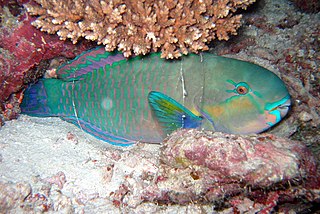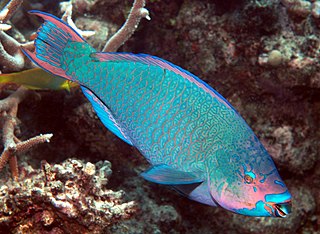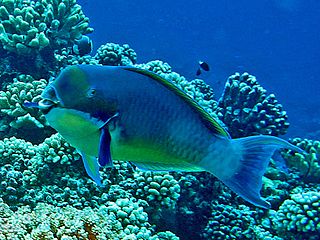
Parrotfishes are a group of about 90 fish species regarded as a family (Scaridae), or a subfamily (Scarinae) of the wrasses. With about 95 species, this group's largest species richness is in the Indo-Pacific. They are found in coral reefs, rocky coasts, and seagrass beds, and can play a significant role in bioerosion.

The green humphead parrotfish is the largest species of parrotfish, growing to lengths of 1.5 m (4.9 ft) and weighing up to 75 kg (165 lb).

Sparisoma is a genus of parrotfishes native to warmer parts of the Atlantic. FishBase recognizes 15 species in this genus, including S. rocha described from Trindade Island in 2010 and S. choati described from the East Atlantic in 2012. They are the most important grazers of algae in the Caribbean Sea, especially since sea urchins, especially Diadema, the other prominent consumers of algae, have been reduced in many places by a recent epidemic.

The marbled parrotfish, also known as the seagrass parrotfish, is a species of marine ray-finned fish, a parrotfish from the family Scaridae and is the only known member of the genus Leptoscarus. It has a wide Indo-Pacific distribution and is also found in the southeastern Atlantic Ocean. It is a coastal species found in beds of sea grass and seaweed.

The checkerboard wrasse is a fish belonging to the wrasse family. It is native to the area including the Indian Ocean to central Pacific Ocean.

The stoplight parrotfish is a species of marine ray-finned fish, a parrotfish from the family Scaridae, inhabiting coral reefs in Florida, Caribbean Sea, Gulf of Mexico, Bermuda and as far south as Brazil. It mainly feeds on algae by scraping and excavating it with its teeth. Like most of its relatives, it is able to change sex.

The doubleband surgeonfish or lieutenant tang, is a marine ray-finned fish in the family Acanthuridae. It is found in the tropical and sub-tropical Indo-Pacific region and grows to a maximum length of 31 cm (12 in).

The rusty parrotfish is a species of marine ray-finned fish, a parrotfish belonging to the family Scaridae. It is associated with reefs in the north western Indian Ocean and the Red Sea.

The queen parrotfish is a species of marine ray-finned fish, a parrotfish, in the family Scaridae. It is found on reefs in the tropical West Atlantic Ocean and the Caribbean Sea. Other common names include blownose, blue chub, blue parrotfish, blueman, joblin crow parrot, moontail, okra peji and slimy head. The young males and adult female queen parrotfish are a reddish-brown color, and quite different in appearance from the bluish-green color of the final phase male. This is a common species throughout its range and the International Union for Conservation of Nature has rated its conservation status as "least concern".

Chlorurus sordidus, known commonly as the daisy parrotfish or bullethead parrotfish, is a species of marine fish in the family Scaridae.

Scarus frenatus is a species of parrotfish. Common names include bridled parrotfish, sixband or six-banded parrotfish or vermiculate parrotfish.

Sparisoma aurofrenatum is a species of parrotfish native to the Caribbean Sea and Western Atlantic Ocean.

Hipposcarus harid, the Longnose parrotfish or Candelamoa parrotfish, is a species of marine ray-finned fish, a parrotfish from the family Scaridae found on coral reefs of Indian Ocean and the Red Sea.

Scarus altipinnis, the filament-finned parrotfish, high-fin parrotfish or mini-fin parrotfish, is a species of marine ray-finned fish, a parrotfish from the family Scaridae. It occurs in the tropical and subtropical Western Pacific Ocean.

Scarus tricolor, also known as the tri-colour parrotfish or three-coloured parrotfish, is a species of marine ray-finned fish, a parrotfish, in the family Scaridae. It has a wide Indo-Pacific distribution.

Chlorurus microrhinos, the blunt-head parrotfish or steephead parrotfish, is a species of marine ray-finned fish, a parrotfish from the family Scaridae. It is found in the Indo-Pacific region.

Calotomus carolinus, commonly known as Carolines parrotfish, is a species of marine ray-finned fish, a parrotfish, in the family Scaridae. It is also known as the starry-eye parrotfish, stareye parrotfish, bucktooth parrotfish, Christmas parrotfish or marbled parrotfish. Since the Calotomus carolinus is known across the Pacific,it also has its own name in many native languages for example, it is called a panuhunuhunu in the Hawaiian language

Chlorurus spilurus, known commonly as the Pacific daisy parrotfish or Pacific bullethead parrotfish and in Hawaiian called uhu, is a species of marine fish in the family Scaridae. The Pacific daisy parrotfish is widespread throughout the tropical waters of the Pacific.

Cetoscarus ocellatus, common name Spotted parrotfish, is a species of parrotfish belonging to the family Scaridae.

Scarus psittacus, the common parrotfish, is a species of marine ray-finned fish, a parrotfish, in the family Scaridae. Other common names for this species include the palenose parrotfish, Batavian parrotfish and the rosy-cheek parrotfish. It has a wide distribution in the Indo-Pacific region where it is associated with coral reefs. This species is utilised as food. It is the type species of the genus Scarus.





















